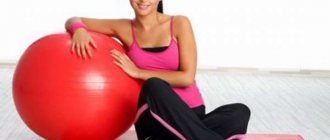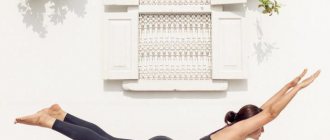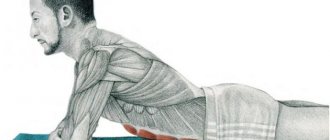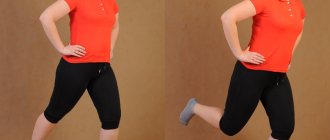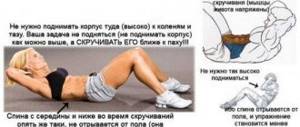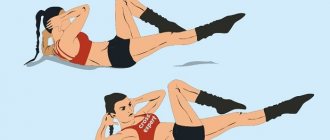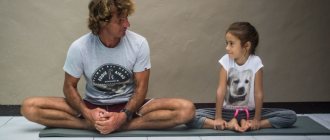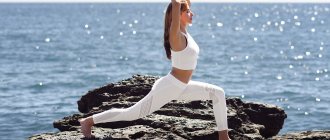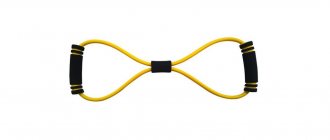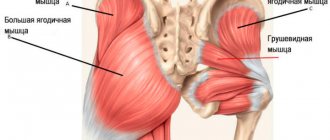Exercise 1
The exercise effectively works all the abdominal muscles.
Starting position: sit on a fitball, feet flat on the floor, cross your arms over your chest. Stepping your feet, carefully lower yourself forward so that your back is on the ball and your knees are under your ankles, keeping your head up without leaning back. From this position, using an isolated effort of the abdominal muscles, begin a slow twist: first the head, then the shoulders, then the middle of the back until you feel a complete contraction of the abdominal muscles. Emphatically slowly return to the starting position.
At the initial stage, start with 1-2 sets of 8-10 repetitions each. Rest between sets for 45 seconds.
Execution option for beginners
When you can easily master this exercise, move on to a more advanced version.
The starting position is the same, with only one exception - the arms are bent at the elbows and placed on the back of the head, do not cross the fingers. Performing the exercise is similar to the option described above. At this stage, perform the exercise in 3 sets of 12 repetitions each. Reduce rest between sets to 30 seconds.
Execution option for advanced
The third option is even more difficult; move on to it only when you can easily perform the second option of the exercise.
The starting position is the same, with only one exception - the arms are straightened behind the head so that they are located close to the ears, in the hands is a medicine ball (can be replaced with a dumbbell weighing 1-3 kilograms or weights can be used). At this stage, perform the exercise in 2-3 sets of 12-15 repetitions each. If you don’t want to use weights, simply perform the exercise with your arms extended behind your head: 4 sets, first 15, then 20 repetitions. Do not bend your arms while doing this.
Complicated version
How to choose gymnastic equipment for training?
To choose the right ball for practice, you need to consider the following:
- The diameter is calculated using the following formula: Your height minus 100 centimeters;
- Having chosen the appropriate diameter, you need to sit down with your feet pressed to the floor, your thighs should be parallel to the floor and your knees perpendicular;
- bright colors will bring more positive emotions and a boost of vigor to your workout;
- Please note the presence of an anti-explosion system, designated ABS or BRQ.
If you add equipment in the form of a Swiss ball to regular exercises, they will bring more effect, help strengthen more muscle groups, and improve flexibility. Fitball for fitness is gaining more and more popularity due to the ease of training with it and the absence of contraindications. You can pump up your buttocks using a fitball only by following the correct technique and regularity. To achieve even better results, it is better to perform the entire set of exercises on a fitball, alternating them or combining them in one day.
Exercise 2
The exercise effectively works the rectus and oblique abdominal muscles.
Starting position: sit on a fitball, feet flat on the floor, knees bent. Stepping your feet forward, lie with your back on the ball, place your right hand on the back of your head.
From this position, tensing the muscles of your buttocks, push your pelvis up. Pull your stomach in and lift your upper body. Then turn your right shoulder to the left. Perform all given repetitions first with the right hand, then with the left.
At the initial stage, start with 1-2 sets of 8-10 repetitions each.
As muscle strength develops, increase the number of sets first to 3, then to 4, and the number of repetitions first to 15, then to 20. Be sure to rest between sets: at the initial stage 30 seconds - 1 minute, at a more advanced stage - reduce the rest time to a minimum .
Highly efficient complex
For those who want to quickly get their figure in order, it is worth performing, in addition to the above exercises, a more effective complex for the legs, buttocks and abs:
- The glute bridge on a fitball is the most effective exercise for working the most important areas of the body. To perform it, lie on your back, place your ankles on the ball, and extend your arms along your body. Lift your knees and buttocks up so that your body forms a bridge. At the top point, emphasis is placed on the full feet and shoulder blades. After a short pause, you can return to i. P.
- Bridge with alternating leg raises. This variation of the bridge on a fitball is more complex, but also more effective for pumping up the desired muscle groups. Having taken the same position as in the previous case, with the buttocks raised, lift your legs one by one, bending them at the knees and pulling your toes away from you. The recommended number of repetitions is 15-20 times.
- Hip abduction. Standing on your knees to the side of the fitball, lean against it with your arm slightly bent at the elbow and lean your body, placing the palm of your other hand on your belt. Raise your leg up and straighten it at the same time, repeating the movement 10-15 times. Then switch sides, lifting with the other leg.
Regular exercise on a fitball is the key to high performance indicators. If you want to pump up and perfect your figure, exercises for the butt and thighs with such a ball should be done as a single set at least three days a week. For those who do not have such an opportunity, a daily workout option of 2-3 exercises on a fitball is suitable.
Exercise 3
The exercise effectively works all the abdominal muscles and also engages the hip flexors.
Starting position: Lie on your back and hold the exercise ball between your ankles, legs straight. Place your hands behind your head and grab any support.
From this position, tightening your abdominal muscles and holding the ball firmly with your feet, pull your knees towards your chest. Then lift your buttocks off the floor. Hold this position for 1-2 seconds, then slowly return to the starting position.
At the initial stage, start with 1-2 sets of 12-15 repetitions each. As muscle strength develops, increase the number of sets to 3-4 and the number of repetitions to 20. Be sure to rest between sets: at the initial stage, 30 seconds - 1 minute, at a more advanced stage, reduce the rest time to a minimum.
Attention: lift your legs only with the force of your abdominal muscles; when performing, try to avoid arching in the lower back; To increase the load, use ankle weights, but reduce the number of repetitions to 12.
Exercise 4
The exercise effectively works all the abdominal muscles, engages the muscles of the buttocks, mid-back, as well as the hip flexors and hamstrings.
Starting position: get down on your knees, body and hips perpendicular to the floor, hands clasped. Without changing the position of your hips, place both hands on the exercise ball. From this position, begin to roll the ball forward. When the body angle approaches 45 degrees, stop, take a deep breath, draw in your stomach and, maintaining the natural curve of your spine, continue to roll the ball away from you until you feel the tension in your abdominal muscles. Then return to the starting position.
Attention: in order not to lose your balance and fall on your stomach on the floor, the speed of rolling out the fitball should be minimal.
Initially, start with 2 sets of 12 repetitions each. As you develop muscle strength, increase the number of sets to 3 and the number of repetitions to 15. Be sure to rest 30 seconds to 1 minute between sets.
Execution option
This embodiment differs only in the initial position of the hands: you lean on the fitball with your hands clenched into a fist.
During training, you can perform either of the two options or do both.
Exercises for abdominal muscles
The main task is to remove lethargy and tighten the abdominal muscles. The exercises are extremely simple, differ from regular exercises in the ease of training: performing on a fitball is noticeably easier, the effect is noticeable quickly.
- Spread your legs shoulder-width apart and place the ball in front. Palms are on the ball. We slowly roll forward slightly, the body reaching for the ball. The back is straight. At the same time, we do a shallow squat, knees bent at an angle of 45 degrees. We do not change the position of the legs.
- Take a wide stance: place your feet shoulder-width apart. We take the projectile, raise it to chest level, arms are bent at the elbow and alternately make turns to the right and left. Can you feel your abs? At first, slowly, as far as possible, without fanaticism. When tension occurs, return to the starting position.
- We do the previous exercise, speeding up the turns and reducing the amplitude. The upper body rotates along with the fitball. The oblique muscles of the abs, arms and back are involved. To finish, it is possible to describe a “figure eight” or “wave” several times in the air with the ball.
Side turns - We sit on the ball, our back is straight, we slowly roll over, and lie down on our back. Exercises where you need to change the sitting position to a lying position are performed exclusively in this way! If you plop down on the ball with your back, you may miss, fall and get injured. Hands behind your head, elbows in a straight line. We lift exclusively the upper part of the body. Without changing body position, we pump up the abdominal muscles with turns to the right and left. The rhythm can be slightly accelerated. Make sure that the lower back does not sag: the load on the back greatly increases, the muscles of the buttocks are incorrectly stretched.
The described exercises are suitable mainly for beginners. Here is a description of a workout with a higher load:
- Let's kneel down. We lean our right side on the ball. We leave the right leg bent in its original position, extend the left leg, move it to the side, and rest the toe on the floor. You need to monitor the position of your legs. Hands behind head. We make shallow bends to the left. We change sides.
- We lower ourselves to the floor, the fitball is clamped between the ankles, hands behind the head. We raise our legs extremely slowly at first to 45 degrees. Lowered to original position. We raise it to 90 degrees. The upper body remains motionless and does not come off the floor. The exercise works well the muscles of the buttocks.
- We lie down on our shoulder blades, the ball is sandwiched between the bones of our feet, and our hands behind our heads. Slowly bend your knees to a right angle and return to the original position. With a new movement we try to pull our legs as close to our chest as possible.
- The position of the torso is as in the previous exercise. Arms extended above head. Slowly raise our legs and arms at the same time, touch the ball with our palms, and return to the starting position. We feel the muscles of the legs.
Raising legs and arms with a fitball - A similar exercise, you don’t just need to touch the fitball, but take it and press it back to the starting position.
- We kneel down, lie on our stomachs on the ball, hands behind our heads, elbows spread out to the side as much as possible. Shallow bends forward and backward. Keep your back straight.
- We kneel down, the ball in front of us. We place our elbows on the ball and swing on our hands for a short time.
- Clasp your hands together and place your elbows on the ball. Slowly raise your body and straighten your back. We return to the starting position.
- Roll over the ball so that the ball occupies a natural depression in the back, hands behind the head, pumping up the abdominal muscles.
Exercises with a gymnastic ball are performed carefully, without jerking. You need to rise and fall carefully, do not fall back, and watch your lower back. The head is in a neutral position; you cannot lower it or press your chin to your neck. Pay special attention to the positioning of your feet.
Exercise 5
The exercise effectively works the abdominal muscles.
Starting position: lie on your back with your legs extended. With straight arms, lift the exercise ball above your head.
From this position, tighten your abs and lift your head, neck, and shoulder blades off the floor while moving the ball toward your feet.
Twist your body further forward and pinch the ball with your feet. As you lower your upper body to the floor, simultaneously lift your legs with the ball clasped upward above you. Then grab the ball with your hands and lift it above your head again, and lower your legs to the starting position.
At the initial stage, start with 1-2 sets of 12-15 repetitions each. As muscle strength develops, increase the number of sets to 3.
In the future, the fitball can be replaced with a weighted medicine ball weighing first 1-2 kilograms, then 3-4 kilograms; or use ankle weights.
Preparation for training
Before classes, be sure to check the elasticity of the fitball; it should be sufficiently inflated and elastic. Before training, stretch and warm up the muscles.
Stretching exercises:
- Cat. Starting position: standing on all fours. Bend your back and raise your head, do a reverse bend. Repeat 3-5 times.
- Tilts. With your arms extended upward, bend toward your torso, alternately to each side. Do 5-6 repetitions.
- Rotations. Place your hands on your waist, rotate your hips clockwise, then counterclockwise. Repeat 8-10 times.
Warming up exercises before training will help avoid injuries and increase the effectiveness of training.
Exercise 6
The exercise works all the abdominal muscles, but mainly the transverse and oblique internal muscles.
Starting position: lie on the floor, place your arms straight behind your head, and hold the exercise ball between your calves.
From this position, tighten your abs, which will bring your spine into a neutral position. Then inhale, bend your knees slightly and lift the exercise ball with your feet 45° from the floor. Exhaling slowly in five counts, using your abdominal muscles, lift your shoulders and head and reach your hands towards the ball. Continuing to keep your legs suspended, lower your head and shoulders to the starting position. Then lower your legs. This will be one repetition.
At the initial stage, start with 1 set of 10 repetitions. As muscle strength develops, increase the number of sets to 2 and the number of repetitions to 12-15 each.
Be sure to rest 30 seconds to 1 minute between sets.
Hitch
At the end of a set of exercises, be sure to stretch to avoid injury and unnecessary muscle pain. And stretching on the ball is double pleasure. First, it bears your body weight, helping you relax. Secondly, it helps relieve stress from the joints.
Training problem areas
For the buttocks, working out the inner and outer parts of the thighs, and legs, squats and bends are suitable, as in regular exercises. The exercises are complex, but significantly effective for modeling these problem areas:
- Bridge with fitball. We lie down on the floor, shoulders pressed to the floor. Feet on the ball. The arms are extended along the body, slightly apart, palms down. Smoothly lift the pelvis up to the end. We don't lower it. On the way up, tighten your hips as much as possible. When we lower it, inhale, when we raise it, exhale. Without changing position, we bend the knee joints of our legs, walk on the ball with our feet, add load to the back of the thighs, and work the leg muscles. We lower ourselves carefully, feeling every vertebra. We finish the exercise by pulling our knees to our chest.
Climbing to the bridge - We pull our right leg towards ourselves as far as possible (everyone has an individual amplitude), opening the knee tendon, the second foot touches the ball. We stretched, then we bent the first leg, placed our foot on the second knee, stretched without tension, felt the muscles of the buttocks. Repeat with the left leg.
- Swing your legs on a fitball. Starting position: lie on the ball with your stomach, arms under your shoulders, hands on the floor. We raise our legs one by one, without bending them. Emphasis on toes.
- We walk two steps forward with our hands, our hips remain on the fitball. Raise your legs to pelvic height. Focus on your hands, raise your legs one by one, but higher than the previous approach. We feel the tension in the hips and buttocks. Try not to strain your back and suck in your stomach.
- We place our foot on the ball, straighten our leg, and roll the fitball from toe to heel. Keep the body straight. It is possible to add squats to the exercise, reaching up with your arms. Then we place our hands with our palms on the ball, move our leg back, and return to the starting position. Repeat with the second leg. This exercise is great for training your abdominal and leg muscles.
- The shoulders and head are on the fitball, the body is straight, the legs are bent at the knees at a right angle. We rest our hands on the floor. We lift and straighten the first leg, hold it for a few moments, then we need to change legs. It is important to not lower your hips when lifting your leg. Make sure that your shoulders and neck remain relaxed, and only the muscles of the lower back, buttocks and abs are tensed. The exercise will become more difficult if you lift your hands off the floor and place them on your belt or hips.
- The press is on a fitball. Palms rest on the floor, feet on tiptoes. Raise your right arm and left leg at the same time. We reached for them. The neck muscles are relaxed, keep your head straight, do not tilt.
Exercises with a fitball for problem areas are recommended to be performed comprehensively, in combination with other methods of body shaping: massage, anti-cellulite wraps, diets. You will simply fall in love with the simulator, feel the fullness of life, and leave several years behind. Daily efforts will definitely bring stunning results.
Exercise 7
Full stretch
Starting position: sit on the fitball, placing your feet at some distance from it. Then lower your hips so that your back, lower back and buttocks rest on the ball at a slight angle. Place your feet slightly wider than your shoulders, bend your knees, and leave your arms hanging down freely.
From this position, while inhaling, straighten your legs and bend in an arc so that the ball is under your back and buttocks, while your feet should remain on the floor.
As you exhale, move your arms straight behind your head and touch the floor with your fingertips. Stay in this position for 30 seconds. Then return to the starting position.
